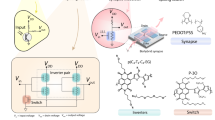Abstract
A fundamental task of the brain is detecting patterns in the environment that enable predictions about the future. Here, we show that the salamander and mouse retinas can recognize a wide class of periodic temporal patterns, such that a subset of ganglion cells fire strongly and specifically in response to a violation of the periodicity. This sophisticated retinal processing may provide a substrate for hierarchical pattern detection in subsequent circuits.
This is a preview of subscription content, access via your institution
Access options
Subscribe to this journal
Receive 12 print issues and online access
$209.00 per year
only $17.42 per issue
Buy this article
- Purchase on Springer Link
- Instant access to full article PDF
Prices may be subject to local taxes which are calculated during checkout



Similar content being viewed by others
References
Rogers, R.L. et al. Electroencephalogr. Clin. Neurophysiol. 83, 146–152 (1992).
Bullock, T.H. et al. Electroencephalogr. Clin. Neurophysiol. 91, 42–53 (1994).
Klinke, R., Fruhstorfer, H. & Finkenzeller, P. Electroencephalogr. Clin. Neurophysiol. 25, 119–122 (1968).
Sutton, S. et al. Science 155, 1436–1439 (1967).
Busse, L. & Woldorff, M.G. Neuroimage 18, 856–864 (2003).
Friedman, D., Cycowicz, Y.M. & Gaeta, H. Neurosci. Biobehav. Rev. 25, 355–373 (2001).
Jaaskelainen, I.P. et al. Proc. Natl. Acad. Sci. USA 101, 6809–6814 (2004).
Mecklinger, A., Opitz, B. & Friederici, A.D. Neurosci. Lett. 235, 65–68 (1997).
Karamursel, S. & Bullock, T.H. Int. J. Neurosci. 100, 1–20 (1999).
Bullock, T.H. et al. J. Neurophysiol. 64, 903–914 (1990).
Karamursel, S. & Bullock, T.H. Electroencephalogr. Clin. Neurophysiol. 90, 461–471 (1994).
Segev, R. et al. Nat. Neurosci. 7, 1154–1161 (2004).
Tiitinen, H. et al. Neuroreport 6, 190–192 (1994).
Acknowledgements
We thank S. Thomas for help with experiments, and A. Fairhall and D. Warland for useful discussions. The work was supported by the US National Eye Institute (R01 EY14196) and by the E. Mathilda Ziegler Foundation for the Blind.
Author information
Authors and Affiliations
Corresponding author
Ethics declarations
Competing interests
The authors declare no competing financial interests.
Supplementary information
Supplementary Fig. 1
Changes in the number of flashes in the sequence. (PDF 103 kb)
Supplementary Fig. 2
OSR strength for different cell types. (PDF 184 kb)
Supplementary Fig. 3
OSR strength versus ON-OFF index. (PDF 176 kb)
Supplementary Fig. 4
Robustness to changes in the stimulus pattern. (PDF 276 kb)
Supplementary Fig. 5
Spatio-temporal patterns. (PDF 127 kb)
Rights and permissions
About this article
Cite this article
Schwartz, G., Harris, R., Shrom, D. et al. Detection and prediction of periodic patterns by the retina. Nat Neurosci 10, 552–554 (2007). https://doi.org/10.1038/nn1887
Received:
Accepted:
Published:
Issue Date:
DOI: https://doi.org/10.1038/nn1887
This article is cited by
-
Omission responses in local field potentials in rat auditory cortex
BMC Biology (2023)
-
Stimulus- and goal-oriented frameworks for understanding natural vision
Nature Neuroscience (2019)
-
A generic deviance detection principle for cortical On/Off responses, omission response, and mismatch negativity
Biological Cybernetics (2019)
-
Sensory representation of an auditory cued tactile stimulus in the posterior parietal cortex of the mouse
Scientific Reports (2018)
-
Frequency selectivity of echo responses in the mouse primary auditory cortex
Scientific Reports (2018)



